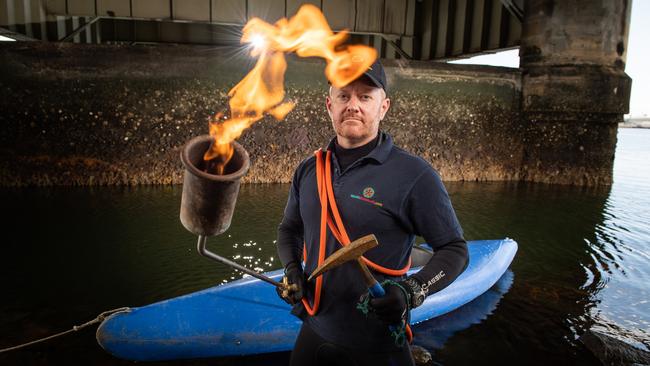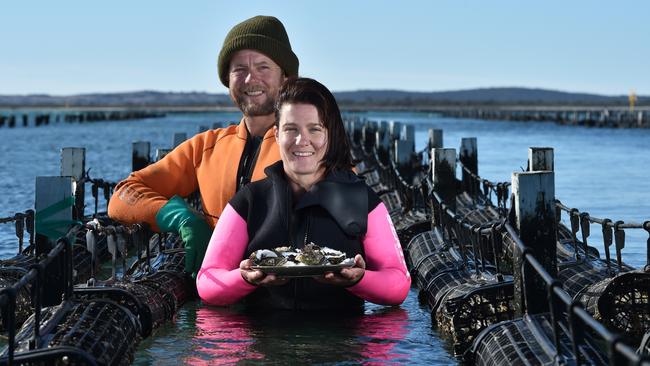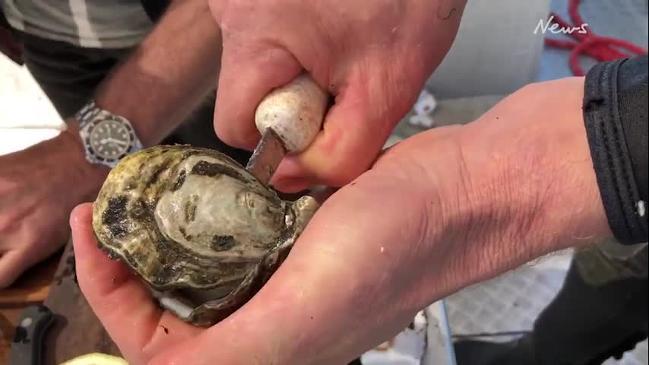Blowtorches used to stop spread of the Pacific oyster Mortality Syndrome over summer
Blowtorches and hammers are being used to destroy feral oysters in Adelaide’s Port River, to spare the industry from a deadly virus.

SA Business
Don't miss out on the headlines from SA Business. Followed categories will be added to My News.
- March: Disease outbreak prompts boat ban
- August: Scientists funded to breed disease-resistant oysters
- October: Prepare for shortage until end of 2020
- November: Dredging Port River could spread disease
Blowtorches and hammers are being used to destroy feral oysters in the Port River to stop a deadly virus spreading to the state’s famed oyster industry.
The State Government has hired a specialist team to kill the feral oyster population in the river after the Pacific Oyster Mortality Syndrome (POMS) was detected there in February. It is the latest in a string of measures by the Government, including a previous boat-travel ban, to protect the state’s eight commercial growing regions from the disease.
Commercial growers are believed to be on alert as POMS becomes active in warmer water, spreads quickly and causes high mortality in Pacific oysters – it does not affect humans.
Primary Industries Minister Tim Whetstone said by reducing the population in the Port River, it would reduce the chance of the virus spreading to the oyster farming areas.

“It’s vital we protect our commercial oyster industry from the threat of POMS and take every measure to reduce the threat of it in South Australia,” Mr Whetstone said.
“The oyster industry’s famed produce is sought after by seafood consumers across Australia and worldwide, bringing benefits to local communities through employment, tourism and flow-on economic activity.”
The commercial sector has been struggling from an ongoing spat (oyster larvae) shortage, created by a POMS outbreak in Tasmania in 2016.
SA growers had received about 80 per cent of their spat from Tasmania but, since the POMS outbreak, an import of spat has been banned.
It has led to a 70 per cent fall in SA production, job losses and business closures, with the industry’s estimated value decreasing from $37 million to $12 million in 2017-18.
SA Oyster Growers Association chairman Rob Kerin said, despite the difficulties, the industry was pleased with the response by Primary Industries and Regions SA to tackle POMS.
“They’ve been terrific and I’ve seen it before with fruit-fly outbreaks, PIRSA seem to be at their best when we have these problems,” Mr Kerin said.

Gazander Oysters owner and SA Oyster Growers Association board member Steve Thomson said growers were cautious and taking precautions leading into summer.
“We do a feral knockdown (of oysters) in our local area at Coffin Bay,” Mr Thomson said.
“The industry is really aware of the issue the feral population could cause because it’s an unmanaged population, so we do our best to control that.
“PIRSA have also got on board with the industry and doing as much as they physically can with the funding and numbers they’ve got. Their response has been great.”
PIRSA has worked to contain POMS to the Port River through various actions, including a ban on removing bivalve shellfish and promotion of biofouling guidelines to boat owners.
In March, fisheries officers also undertook a mass clean-up of the river and reduced feral oyster populations in some areas but PIRSA said total eradication was not possible.
Early detection surveillance over the autumn and spring period this year has returned negative results for the presence of POMS in all oyster growing regions.
PIRSA is also working with hatcheries to develop biosecurity plans.
The latest destruction of feral oysters started on December 12 and is expected to be finished before the end of the year.
SPREAD OF POMS
February 2016
Pacific Oyster Mortality Syndrome (POMS) is discovered in Tasmania and decimates the $24 million industry.
The discovery closed the borders to SA growers who had received 80 per cent of their spat (oyster larvae) from the region.
October 2017
South Australia’s industry prepares for a 50-70 per cent dive in production as the state’s hatcheries fail to keep up with demand for spat.
Production numbers are not expected to fully recover until mid-2019, as oysters take 18 to 24 months to grow.
February 2018
The State Government waives lease and licence fees for two years as the industry battles unparalleled drop in production and job losses.
POMS is detected in feral oysters in Adelaide’s Port River during routine surveillance.
Primary Industries and Regions SA immediately implements a ban on the removal of oysters, mussels and cockles from the river, including for bait or berley.
March 2018
Fisheries officers start a mass clean-up of the Port River to remove feral oysters.
PIRSA implements a temporary ban on vessels moored in the river in the past two months from travelling near Yorke Peninsula and Kangaroo Island oyster growing regions.
April 2018
PIRSA testing confirms POMS has not spread to SA’s eight commercial growing regions.
August 2018
SA scientists receive extra funding to continue breeding disease-resistant oysters to safeguard industry.
December 2018
The State Government contracts a company to use blowtorches and hammers to remove more feral oyster populations from the river, as POMS spreads in warmer waters.


